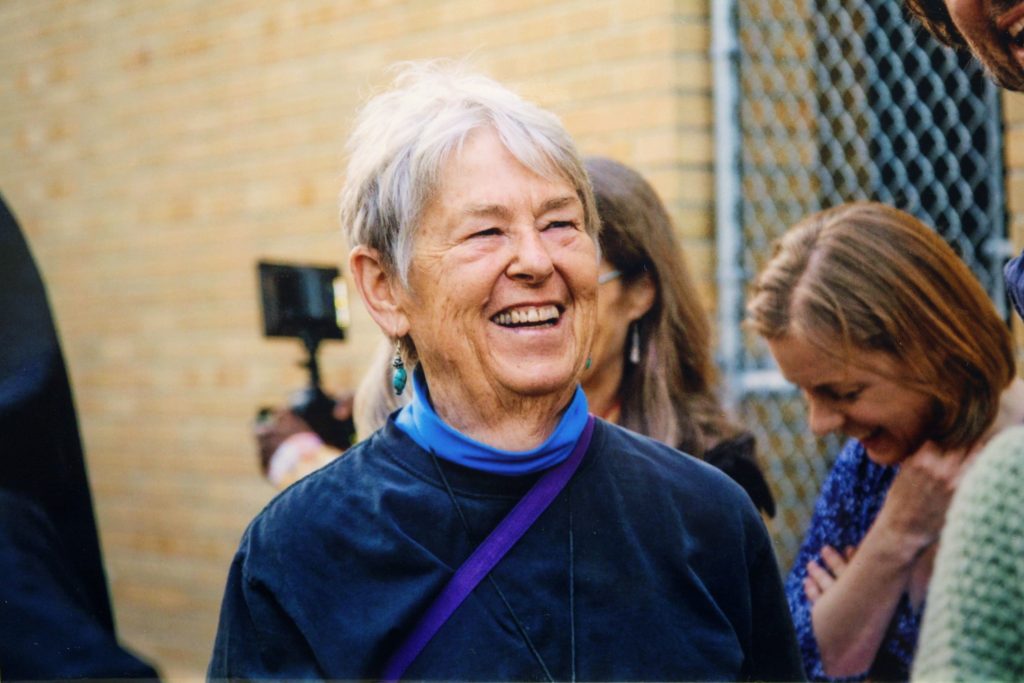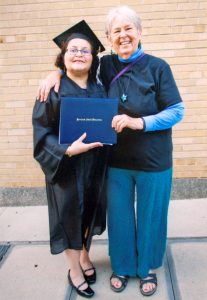Arline Saturdayborn: Ten years later, a teacher continues to learn
August 28th, 2018 | Careers, SIT Graduate Institute

When Arline Saturdayborn found SIT’s TESOL master’s degree program, she knew it represented the work she had been looking for her entire life. With an MA from Harvard, Arline had been teaching high school, but didn’t love the work. After completing a brief course in teaching English as a foreign language, she began working with immigrants and found she loved it, but she was still looking for different ways to better understand the experiences and journeys that bring students to her classroom at Portland Adult Education in Maine.
To find out more about SIT Graduate Institute, Arline, then 66, drove down to Vermont. “I was so afraid they were going to tell me I was too old,” she recalls. What she found instead was a culture of inclusion. Several years later, in 2012, Arline became part of SIT’s first low-residency TESOL program. Later, she completed a certificate in peacebuilding and conflict transformation with SIT’s CONTACT (Conflict Transformation Across Cultures) program.
Now 76, Arline refuses to let her age define or limit her, and her work continues to evolve, informed by her SIT experiences and inspired by the grit and determination of her students from around the world.
Can you describe your experience with the MA TESOL program?
At that time, I was in my late 60s and I had to struggle with the cultural preconceptions about aging, I was not going to let that dictate in my life. I got incredible support and affirmation at SIT. The faculty was incredible; the other students were incredible. It was like my mind was being set on fire.
The program started in June, then we came together at the end of July. My biggest hang-up was my age. How would people see me? Would they take me seriously? The whole face-to-face portion of the program helped me to see the power of cultural conditioning. There is an incredible ageism in U.S. culture; if you’re a woman over 45 you’re invisible. That had an impact — and it was a very limiting impact — on me.
You take in limiting bias about yourself unconsciously; SIT does not support that. At SIT, there was acceptance of who I was and what I was doing. It helped me enormously because we did a lot of cultural experiences and I was able to apply that to myself: the youth-obsessed culture that I grew up in was not the culture I wanted to live my life from.
Did your program influence the way you were teaching at that time?
The effect was immediate and has continued to be that way. If I am lucky enough to teach another 20 years, I will continue to learn from it. A big part of it was the harmony between the content and the practice — the way the faculty worked with us as students.
I was teaching three classes in Portland, so I had the opportunity to experiment — not just reading and talking about it but trying it out every day. My supervisor came at least twice to supervise me. She visited my classes and met with me after. That was incredibly affirming. She saw who I was and what I was doing and validated it.
What do you mean when you say you continue to learn?
Because I take what I got from the training and I apply it to the lesson I’m teaching. So, in the middle of the lesson I might think, “What about if I apply it this way?”
Does that vary according to the changing immigrant population?
I’m just starting my 14th year of teaching here, and the population has changed a lot. Previously, my students were predominantly Somali, and many were not educated at all, so it was a very difficult struggle for them to get a high school diploma. Now, some are from Vietnam and Cambodia, but most are from central and west Africa and they are highly educated professionals, but they don’t have the English language. Because they are professionals with higher education, and because many of them have gone through high school, they learn much more quickly, so we’ve had to change our curriculum to meet these needs.
Can you tell me about some of your students?
One person was a lawyer from Central America who was humiliated to come to school, and now she’s on her way to working in the medical field. She was graduation speaker last year for her high school diploma. I also teach stress reduction; I begin classes with movement and mindful breathing. She ended her speech saying, “I learned from my teacher Arline that, yes, I can do this. I just breathe in, breathe out.”
Another student had a job interview, and the interviewer asked how he would handle stress. My student said, “I got up and showed him what I learned in your class, and he hired me right there!”
You also chose to do the SIT CONTACT certificate program. How has that influenced your teaching?

CONTACT evolved from my teaching and the low-res MA TESOL program. The second year [of MA TESOL] we had to write an independent professional project (IPP). I was interested in how people could teach without getting burned out. As I researched, I discovered a program called Sustainable Compassion Training for Educators. For my IPP, I taught Sustainable Compassion Training to teachers in my school who were highly stressed and burned out. I wrote about it as part of my IPP and because it was so beneficial for the teachers I went on to take the training to become a sustainable compassion trainer.
I always felt my work as an ESOL teacher was peace work — my students are victims of incredible torture and agony from wars and conflict in their countries. In doing my IPP, I saw how sustainable compassion training helped their teachers, and I thought it could help people who are working for peace, so I needed to know what peacebuilders do. That's what led me to CONTACT, which has informed my teaching profoundly because as a result of CONTACT I’m grounded in the greater knowledge of the complexity of the world that brings these students here to us.
Peacebuilding work and teaching can be extremely discouraging and challenging, and I want to offer this as a tool so that people can stay in the work they’re doing without getting burned out. Sustainable compassion training is the kind of practice that Nelson Mandela and Martin Luther King, Jr., had, which allowed them to do the kind of work they did — to meet violence with love, realizing you can’t solve a problem by the same means that you create a problem.
If I’m inspiring — whatever that energy is — it was ignited and supported and sustained by SIT.
